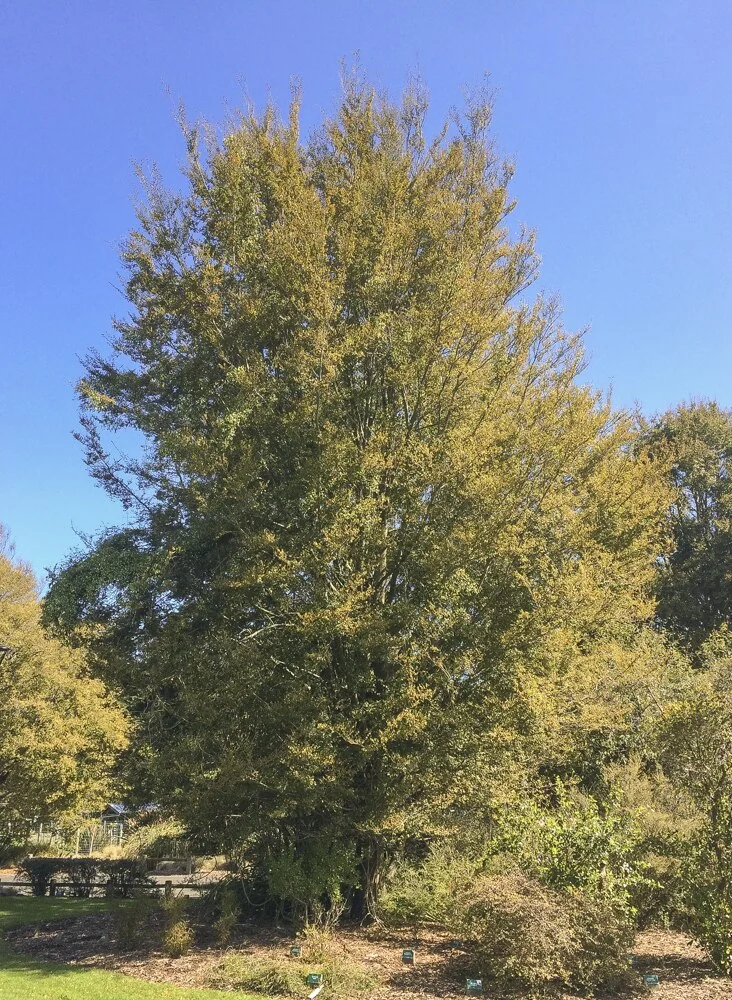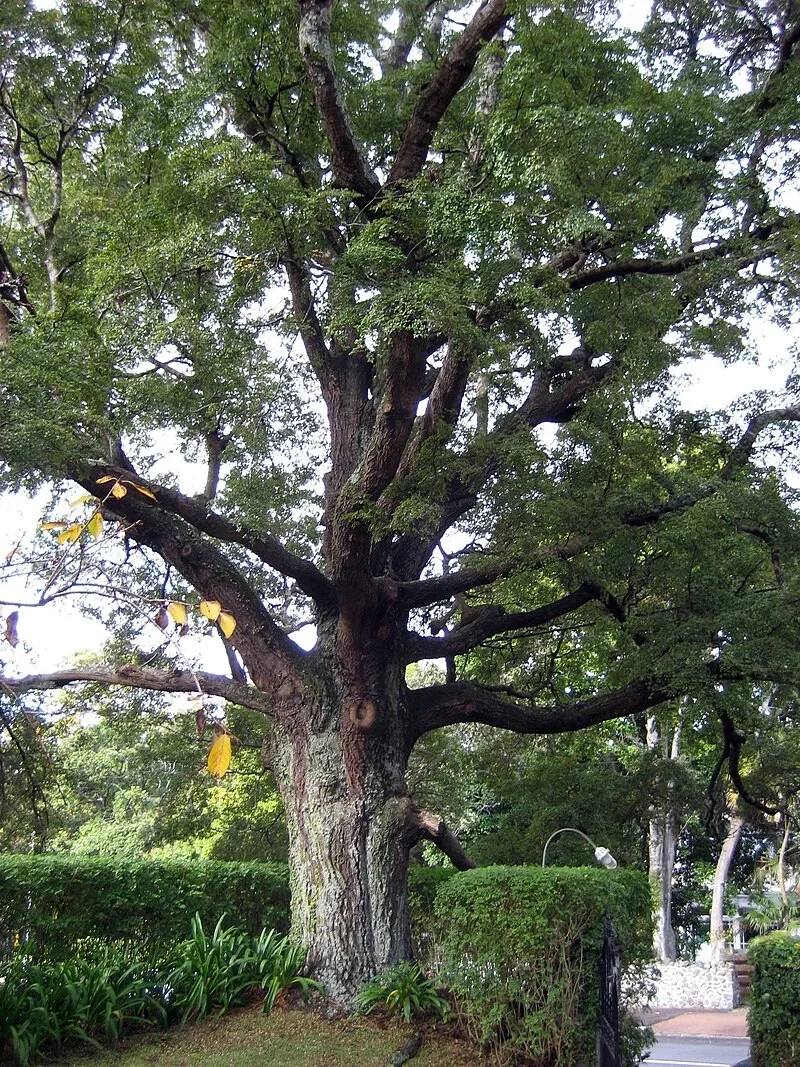
Red Beech
Nothofagus fusca
Nothofagus fusca , commonly known as Red Beech or by its Māori name tawhai raunui, is an evergreen Southern Beech species native to New Zealand. It is found on both the North and South Islands, typically in lower hills and inland valley floors with fertile, well-drained soil. This tree is valued for its attractive foliage, which transforms into vibrant shades of red and gold in autumn. It can grow to a substantial size, typically reaching 20 to 30 meters, and sometimes even taller, with a broad, rounded canopy that is about half its height. The bark is reddish-grey, initially smooth but developing vertical ridges and fissures with age. Its leaves are alternately arranged, broad ovoid, 2 to 4 cm long, and 1.5 to 3 cm broad, featuring distinctively double-toothed margins.

Plant Description
Fuscospora fusca (red beech; formerly Nothofagus fusca ) is a large, longÃÆÃ'¢ÃÆâââ⬠¡¬Ã¢Ã¢â¬Ã lived forest tree to 30+ÃÆÃ'ââ⬠¡ m with dark, fissured bark and firm, toothed leaves. Timber is hard and durable; nuts (beechnuts) occur in small, threeÃÆÃ'¢ÃÆâââ⬠¡¬Ã¢Ã¢â¬Ã valved cups.
Quick Facts
| Scientific Name | Nothofagus Fusca |
|---|---|
| Common Name | Red Beech, tawhai raunui |
| Plant Type | Evergreen Southern Beech |
| Height | 20-30 m (can be taller) |
| Spread | 15-20 m canopy spread |
| Canopy | Broad, rounded, about half its height |
| Bark | Reddish-grey, smooth when young, fissured with age |
| Leaves | Alternately arranged, broad ovoid, 2-4 cm long, 1.5-3 cm broad, double-toothed margins, vibrant red and gold in autumn |
| Reproduction | Monoecious, wind-pollinated |
| Habitat | North and South Islands, lower hills, inland valley floors with fertile, well-drained soil |
| Climate | Temperate, cool summers, mild winters, moderate to high rainfall |
| Growth Rate | Moderate to fast |
| Soil | Well-drained, fertile, slightly acidic to neutral pH (5.5-7.5) |
| Sun | Full sun to partial shade |
| Flowers | Small, inconspicuous, wind-pollinated, monoecious |
| Fruit | Small cupule containing three seeds, mast years every 2-3 years |
| Water Needs | Moderate to high, keep soil moist but well-drained |
| Light | Full sun to partial shade |
| Frost Tolerance | High, hardy to -10ÃÆÃ'ââ⬠¡°C when established |
| Salt Tolerance | Low, not suitable for coastal exposure |
| Lifespan | 500-600 years |
| Climate Cities | Suitable for Christchurch, Dunedin, Invercargill, Nelson, Queenstown |
| Uses | Ornamental, ecological importance, timber (flooring), black dye, tannin source |
Climate Best Suited to
Cool to mild temperate climates with reliable rainfall; tolerates frost and snow at higher elevations; prefers free-draining, relatively fertile soils.
Regional Suitability
| City | Climate Suitability |
|---|---|
| Whangārei | Ideal |
| Auckland | Ideal |
| Hamilton | Ideal |
| Tauranga | Ideal |
| Rotorua | Ideal |
| Gisborne | Ideal |
| New Plymouth | Ideal |
| Napier | Ideal |
| Whanganui | Ideal |
| Palmerston North | Ideal |
| Wellington | Ideal |
| Nelson | Ideal |
| Christchurch | Ideal |
| Dunedin | Ideal |
| Invercargill | Ideal |
Natural Habitat
Dominant canopy tree of lowland to montane forests in central and southern North Island and much of the South Island, often on wellÃÆÃ'¢ÃÆâââ⬠¡¬Ã¢Ã¢â¬Ã drained slopes and terraces.
Plant Conservation
Widespread; local declines associated with browsing and pathogens in some beech species warrant ongoing monitoring.
Seedling recruitment pulses follow gap creation after windthrow or selective loss; leaving decaying logs and lightwells encourages natural regeneration beneath mature canopies.
How to Grow
Red Beech (Nothofagus fusca) is a magnificent forest tree that, while slow to establish, is a rewarding long-term investment for temperate gardens and restoration projects. It thrives in cool, moist climates with well-drained, fertile soils, mimicking its natural habitat.
Planting Guide
Best Planting Practices
Plant in autumn/winter with ample space (10-15 m). Mulch to reduce competition; protect from stock and rabbits during establishment.
In open ground, rip or loosen a wide planting zone and remove competing grass; set the root collar at soil level, water deeply, and mulch generously out to the dripline. Shelter young trees from hot nor'westers and browsing; stake only where wind rock is likely. Space widely to reflect eventual stature.
Ecology
Key canopy species supporting diverse bird and invertebrate communities; mast seeding drives ecosystem dynamics.
Beech forests produce irregular mast seed crops that pulse resources to kākā, kākāriki and a wide guild of invertebrates; the litter builds deep, spongy soils and sustains fungal networks. Mixed with podocarps on terraces and slopes, it creates complex, resilient canopies across temperate valleys.
Uses
Timber (historically), large-scale restoration and shelter belts in appropriate climates.
Today, red beech is prized for ecological restoration, long-lived shelter and riparian plantings rather than timber. Its strong frame, filtered shade and splendid autumn toning make it a noble park or station tree where space allows and soils are freely drained.
Landscaping Ideas
Best for large properties and restoration plantings; pair with Podocarpus and Fuscospora associates.
Plant in groves to emulate mixed valley forests, or as an avenue on deep, well-drained loams. Underplant with shade-tolerant ferns and Coprosma to build layered structure and support bird movement through the property.
Seasonal Care
Winter
Plant and stake if exposed; check guards.
Summer
Water during prolonged drought in first 2-3 years.
Through the second summer, a single deep soak each dry fortnight is better than frequent light watering, which promotes shallow roots and wind rock.
Pruning
Pruning Techniques
Minimal; remove crossing branches on young trees to establish a clear leader.
Time any corrective work for mid to late winter while sap flow is low; sterilise tools between cuts to reduce pathogen spread.
How to Grow Red Beech
Red Beech grows best when you match its natural habitat: prepare wellâââ¬Ãâââ¬Ã drained soil, get the light right, water steadily, and protect from extremes during establishment. Dig wide planting holes, set the crown at original depth, water to settle, and mulch with coarse organic matter to conserve moisture while keeping the stem base dry. Feed lightly in spring; heavy nitrogen is unnecessary and can weaken growth.
Seed
Sow fresh, viable seed on a free-draining mix, cover lightly with fine grit, and keep evenly moist in bright light out of harsh sun. Germination timing varies; prick out once roots hold the media and harden off gradually.
Division
Where the species permits, divide robust clumps in early spring as new growth begins. Replant divisions with several shoots into fresh mix, water thoroughly, and maintain steady moisture until reâââ¬Ãâââ¬Ã established.
Cuttings
For shrubs and many perennials, strike semiâââ¬Ãâââ¬Ã hardwood cuttings in late spring to summer in a coarse, free-draining propagation mix under gentle bottom heat and high humidity. Reduce leaf area, ventilate progressively as roots develop, and pot on before planting out.
Afterâââ¬Ãâââ¬Ã care
Maintain an open mulch, irrigate during drought in the first season, and prune or tidy according to the species to build a resilient framework. Adjust shade, wind exposure and watering to prevent stress, and refresh mulch annually for longâââ¬Ãâââ¬Ã term performance.
Pests and Diseases
Common Problems and Solutions
Browsing by possums/deer on seedlings; Phytophthora and beech scale issues in some regions-ensure good site hygiene.
Where Phytophthora risk is high, avoid compaction around the dripline and keep mulch clear of the trunk collar to improve aeration.
Cultural Significance
Red Beech holds significant cultural importance for Māori, who know it by several traditional names including tawhai raunui, hutu, and hututawai. The species features prominently in Māori legends and folklore, representing strength and longevity in the natural world.
Traditionally, Māori utilized Red Beech wood extensively for carving, construction, and creating various implements due to its durability and workability. The timber's strength and straight grain made it particularly valuable for structural purposes. Red Beech also generates honeydew, which was appreciated by Māori as a natural sweetener and continues to be favored by native birds and bees today.
Bonus Tip
Expert Growing Advice
Site away from compacted lawns-deep, undisturbed soil promotes strong anchorage and longevity.
Interplant with hardy nurse species to shelter saplings in exposed paddocks; remove the nurses gradually as the beech crowns knit.







